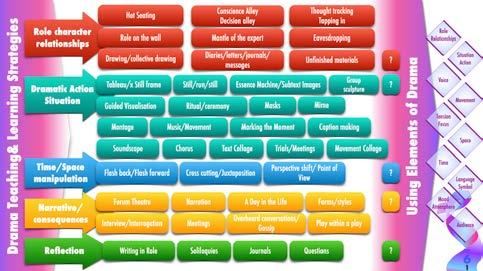
1 minute read
Ideas for Drama Thinking – A Process Drama Approach
WhAt is Process DrAmA?
In this workshop we are developing a Process Drama which provides one entry point for learning drama. The workshop is structured as an extended series of linked drama experiences given coherence through narrative; interspersed within the structure are opportunities for active reflection and connection to future practice (Schön, 1983).
Advertisement
hoW Process DrAmA Works
Process Drama uses improvisationally- based explorations within the frame of a series of negotiated structured episodes working with the Elements of Drama (ACARA, 2022). Working collaboratively teacher/leader and participants/actors physically, cognitively, and emotionally explore people and stories working with the conventions and strategies offered by drama/theatre for an underlying educational purpose.
In a Process Drama workshop, participants are simultaneously actors and audience. They work within the tension between enacting imagined action and their personal and collective physical presence in the workshop. This metaxis (after Boal, 1993; Pascoe, 2020) provides a “heightened state of consciousness” through working physically, cognitively and emotionally with the Elements of Drama.
Through working with role, relationships, situations, action, tension, voice and movement, space and time, language and symbol, mood and atmosphere, and audience, participants learn the distinctive properties of drama in practice.
Through participating in Process Drama, we learn drama. We learn how drama makes and shares meaning and how experiences are expressed and communicated. Through shaping and forming ideas through enactment, sharing them through performing and reflecting on them and through responding, we learn the concurrent dynamics of drama as artists and audiences.
strAtegies
Process Drama relies upon the effective use of a range of drama learning and teaching strategies, sometimes known as conventions (Neelands & Goode, 2000). They connect with the rich repertoire of theatre handed down from generation to generation in the art form.
Opportunities are provided by Process Drama for learning through heightened aesthetic engagement. Three core drivers ignite aesthetic engagement: narrative, role and tension (Pheasant, 2015). In Process Drama the purposeful use of productive tension (Cecily O’Neill, 2014, drawing on ideas from Heathcote) powers embodied engagement. Tensions of character, relationships, task, time and surprise can be managed to explore the narrative (Haseman & O’Toole, 2017).
In Process Drama participants have dual roles of been artist and audience simultaneously. They metaxically engage in active reflective and reflexive learning. There is a dual state of awareness, what Maxine Greene (1995)called a ‘wide awakeness’, and active embodied transformation.
ActivAte your leArning
• Create an info-graphic explaining key features of Process Drama.
• Prepare a briefing for your Principal/school about how Process Drama enables students to learn drama.
WhAt Are the elements of DrAmA? AnD Why Are they imPortAnt?
In this workshop we are working in Process Drama through using the Elements of Drama which provides further entry points for learning drama.



